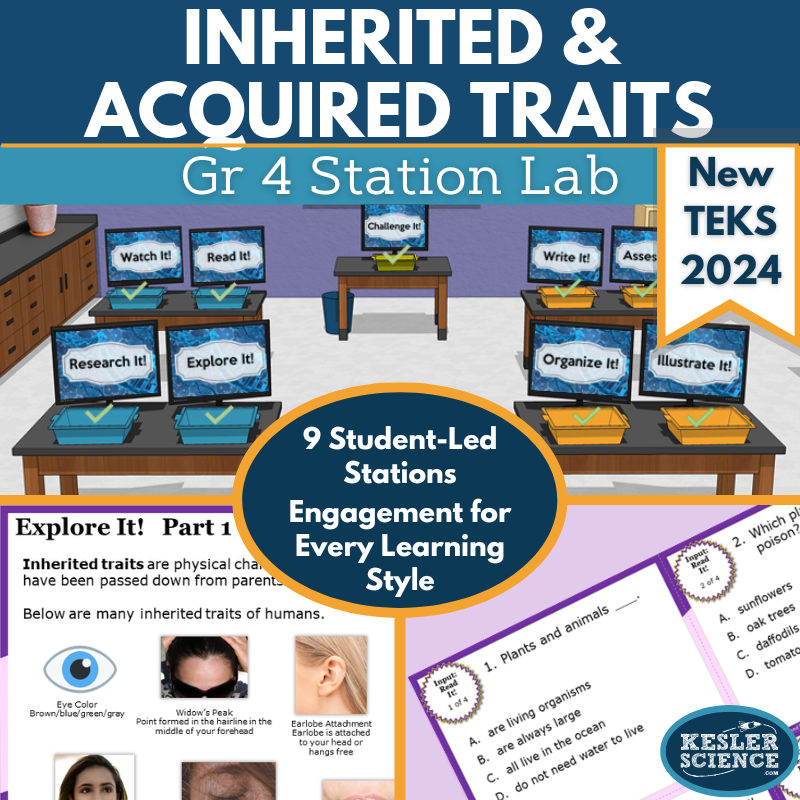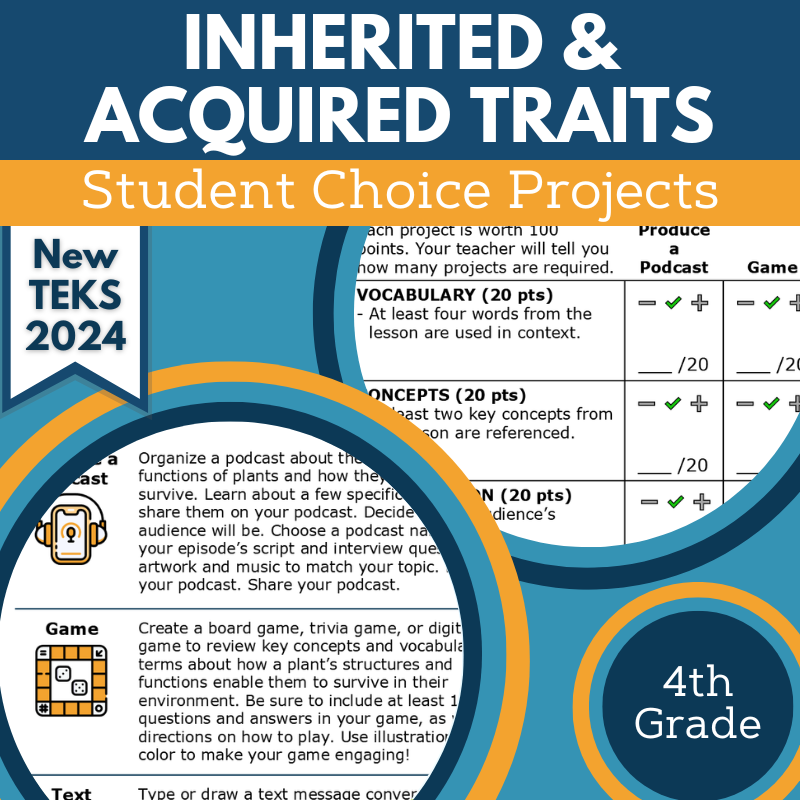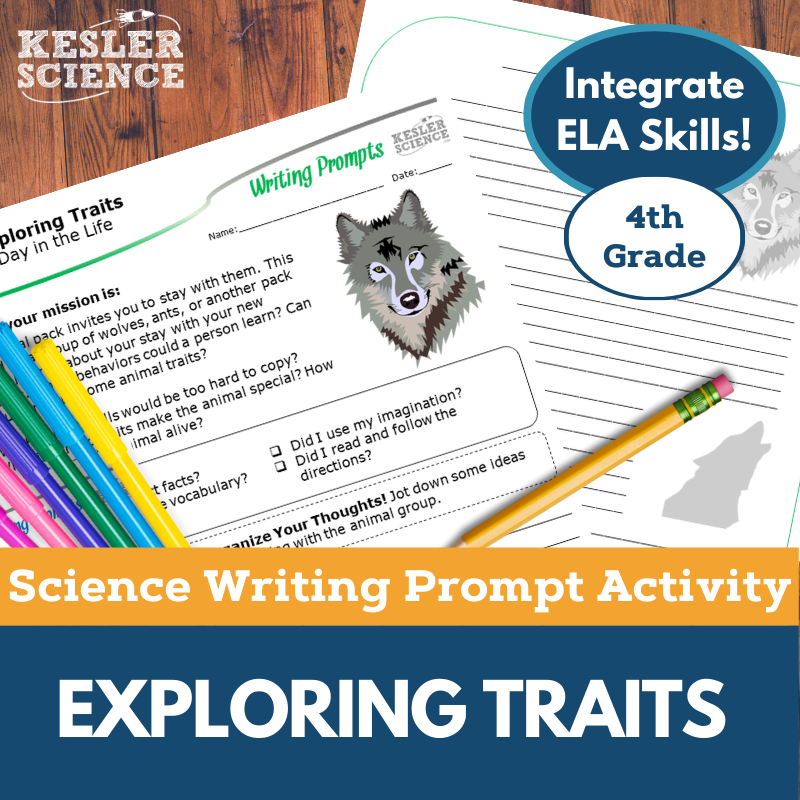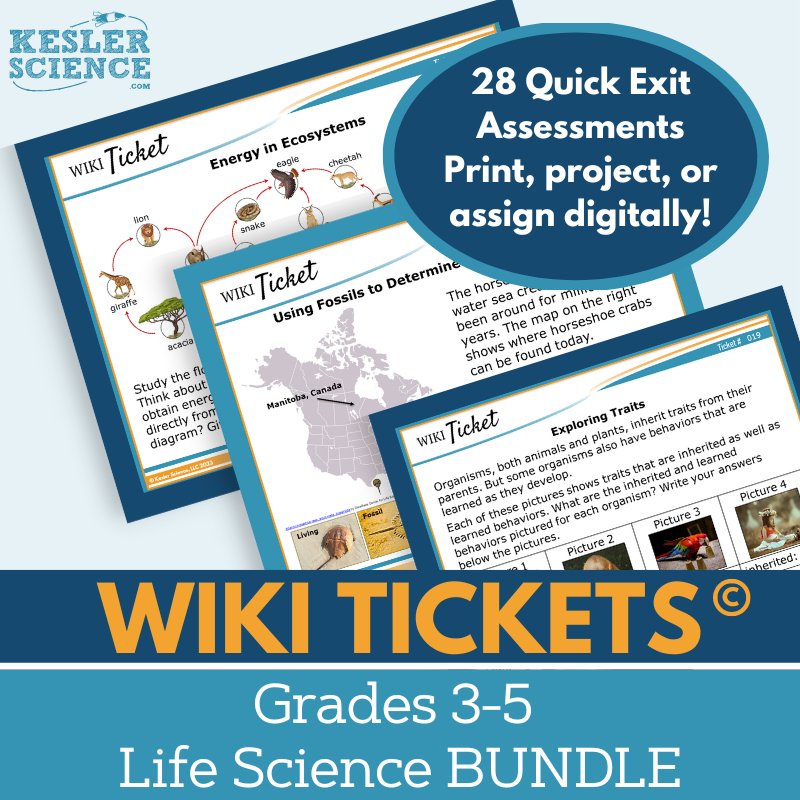Inherited & Acquired Traits Activities for 4th Grade Science
This elementary life science unit helps students distinguish between inherited and acquired physical traits, offering a variety of engaging, student-led activities. Aligned with TEKS 4.13B, the unit includes editable presentations, worksheets, hands-on demos, research tasks, and interactive assessments, all designed to promote active learning with minimal prep. Following the 5E Model, students explore key concepts through vocabulary discussions, differentiated stations, and choice projects. Additionally, the unit includes Spanish translations for key materials, ensuring accessibility for all learners in both in-class and virtual settings. The resources below will give students a comprehensive understanding of inherited and acquired traits. All of the following materials are also included in the Kesler Science Membership.
This elementary life science unit focuses on differentiating between inherited and acquired physical traits. It includes presentations, worksheets, choice projects, and assessments, all designed for student-led learning with minimal prep. Aligned with TEKS 4.13B, the unit offers flexibility in formats (printable and digital) and is fully editable.
The lesson follows the 5E Model, with activities covering engagement, exploration, explanation, elaboration, and evaluation. In the engagement phase, students explore vocabulary and class discussions. The exploration phase features differentiated student-led stations, including hands-on demos, reading passages, research, videos, and tasks for students to demonstrate understanding. The explanation phase includes editable PowerPoints and interactive notebooks. In the elaboration phase, students can extend their learning through choice projects. The evaluation phase includes STAAR 2.0-aligned assessments and review materials.
The unit includes Spanish translations for key materials, ensuring accessibility for all learners. It is ideal for both in-class and virtual learning environments.
This elementary life science unit focuses on differentiating between inherited and acquired physical traits. It includes presentations, worksheets, choice projects, and assessments, all designed for student-led learning with minimal prep. Aligned with TEKS 4.13B, the unit offers flexibility in formats (printable and digital) and is fully editable.
The lesson follows the 5E Model, with activities covering engagement, exploration, explanation, elaboration, and evaluation. In the engagement phase, students explore vocabulary and class discussions. The exploration phase features differentiated student-led stations, including hands-on demos, reading passages, research, videos, and tasks for students to demonstrate understanding. The explanation phase includes editable PowerPoints and interactive notebooks. In the elaboration phase, students can extend their learning through choice projects. The evaluation phase includes STAAR 2.0-aligned assessments and review materials.
The unit includes Spanish translations for key materials, ensuring accessibility for all learners. It is ideal for both in-class and virtual learning environments.
The student-led, modular station lab aligns with the 2021 TEKS 4.13B standard and focuses on the physical characteristics of organisms. Designed for 4th grade, it engages students in exploring inherited and acquired traits. The lesson provides differentiated activities that allow students to direct their own learning while the teacher facilitates.
In this station lab, students will work through nine stations, each offering various ways to explore the topic. Input stations include activities like "Explore It!" where students apply concepts, "Watch It!" for a video on traits, "Read It!" with passages in English and Spanish, and "Research It!" for deeper understanding through images and graphs.
Output stations let students show their learning through activities such as "Organize It!" with hands-on manipulatives, "Illustrate It!" where they draw examples of traits, "Write It!" for short-answer responses, and "Assess It!" for task card-based assessments. A bonus station, "Challenge It!", provides extension activities for advanced learners.
This resource works for both in-person and virtual learning environments.
The student-led, modular station lab aligns with the 2021 TEKS 4.13B standard and focuses on the physical characteristics of organisms. Designed for 4th grade, it engages students in exploring inherited and acquired traits. The lesson provides differentiated activities that allow students to direct their own learning while the teacher facilitates.
In this station lab, students will work through nine stations, each offering various ways to explore the topic. Input stations include activities like "Explore It!" where students apply concepts, "Watch It!" for a video on traits, "Read It!" with passages in English and Spanish, and "Research It!" for deeper understanding through images and graphs.
Output stations let students show their learning through activities such as "Organize It!" with hands-on manipulatives, "Illustrate It!" where they draw examples of traits, "Write It!" for short-answer responses, and "Assess It!" for task card-based assessments. A bonus station, "Challenge It!", provides extension activities for advanced learners.
This resource works for both in-person and virtual learning environments.
The Student Choice Projects on inherited and acquired traits align with the 2021 TEKS standard 4.13B and offer 4th graders the opportunity to select a project that matches their preferred output style. A project page details six student-led project options along with a "design your own" project. Teachers, peers, or students can use the included grading rubric for assessments. The flexible and multimodal projects allow for creativity and personalization, and teachers can modify the rubric to meet their grading needs.
The resource includes nine project options plus a “design your own” project, a Teacher Directions page with suggestions, and editable rubric pages that assess vocabulary, concepts, presentation, clarity, and accuracy. There are two versions of the project page, with one offering modifications for students needing remediation and differentiation, while the other provides challenge options for advanced students. The projects use standard classroom supplies like paper, markers, and scissors, and many can be completed digitally.
The Student Choice Projects on inherited and acquired traits align with the 2021 TEKS standard 4.13B and offer 4th graders the opportunity to select a project that matches their preferred output style. A project page details six student-led project options along with a "design your own" project. Teachers, peers, or students can use the included grading rubric for assessments. The flexible and multimodal projects allow for creativity and personalization, and teachers can modify the rubric to meet their grading needs.
The resource includes nine project options plus a “design your own” project, a Teacher Directions page with suggestions, and editable rubric pages that assess vocabulary, concepts, presentation, clarity, and accuracy. There are two versions of the project page, with one offering modifications for students needing remediation and differentiation, while the other provides challenge options for advanced students. The projects use standard classroom supplies like paper, markers, and scissors, and many can be completed digitally.
The Exploring Traits Science and ELA Integrated Writing Activity engages 4th-grade students in creatively showcasing their understanding of animal behaviors within a pack. Using a "day in the life" format, this fun and interactive activity enhances science reasoning and writing skills. Designed for both in-person and virtual learning, it keeps students engaged inside and outside the classroom.
Aligned with TEKS and NGSS standards, this low-prep, student-centered resource is ideal for elaboration, review, or as a complement to other Kesler products. The activity includes teacher directions with an answer guide, project ideas, and rubrics; projection and print-friendly handouts; and a digital interactive version in PowerPoint, compatible with Google Slides for remote learning.
This versatile prompt works well for cross-curricular activities, pre-test assessments, student choice projects, early finisher tasks, extra credit, make-up work, TELPAS samples, or differentiation exercises. Finished work can be displayed on bulletin boards or compiled into student anthologies. It assumes students have prior knowledge of the topic or access to research materials.
The Exploring Traits Science and ELA Integrated Writing Activity engages 4th-grade students in creatively showcasing their understanding of animal behaviors within a pack. Using a "day in the life" format, this fun and interactive activity enhances science reasoning and writing skills. Designed for both in-person and virtual learning, it keeps students engaged inside and outside the classroom.
Aligned with TEKS and NGSS standards, this low-prep, student-centered resource is ideal for elaboration, review, or as a complement to other Kesler products. The activity includes teacher directions with an answer guide, project ideas, and rubrics; projection and print-friendly handouts; and a digital interactive version in PowerPoint, compatible with Google Slides for remote learning.
This versatile prompt works well for cross-curricular activities, pre-test assessments, student choice projects, early finisher tasks, extra credit, make-up work, TELPAS samples, or differentiation exercises. Finished work can be displayed on bulletin boards or compiled into student anthologies. It assumes students have prior knowledge of the topic or access to research materials.
The WIKI Tickets© formative assessments offer an engaging way to check student understanding in 3rd–5th grade science. This Life Science Set includes 28 assessments, each available in five formats: a full-screen projection version, three printable handout sizes, and an interactive digital version compatible with PowerPoint and Google Slides.
Aligned with NGSS and TEKS standards for upper elementary science, every standard is covered by at least one ticket, with some topics offering multiple options. A bonus table of contents file highlights the standards alignment.
These versatile assessments can be used in both in-person and virtual settings. Topics covered include animal groups for survival, changes in ecosystems, energy flow in food webs, inherited traits, internal and external structures, fossil evidence, and plant growth, among others.
WIKI stands for "What I Know Is." These colorful, flexible assessments can be used as exit tickets, bellringers, or quick checks for understanding. They can be projected, printed, or assigned digitally through PowerPoint or Google Slides, making them adaptable for any classroom environment.
The WIKI Tickets© formative assessments offer an engaging way to check student understanding in 3rd–5th grade science. This Life Science Set includes 28 assessments, each available in five formats: a full-screen projection version, three printable handout sizes, and an interactive digital version compatible with PowerPoint and Google Slides.
Aligned with NGSS and TEKS standards for upper elementary science, every standard is covered by at least one ticket, with some topics offering multiple options. A bonus table of contents file highlights the standards alignment.
These versatile assessments can be used in both in-person and virtual settings. Topics covered include animal groups for survival, changes in ecosystems, energy flow in food webs, inherited traits, internal and external structures, fossil evidence, and plant growth, among others.
WIKI stands for "What I Know Is." These colorful, flexible assessments can be used as exit tickets, bellringers, or quick checks for understanding. They can be projected, printed, or assigned digitally through PowerPoint or Google Slides, making them adaptable for any classroom environment.
Year-Round Resources
These year-round activities will increase your students' understanding of many middle school science topics. All of these activities are also included in the Kesler Science Membership.
Visual Data & Graphing
You're not alone if your students struggle with understanding graphs, charts, and tables. It's a skill that takes an enormous amount of practice. This resource will help students build a strong foundation in analyzing data and creating their own data visualizations.
Bell Ringers and Warm-Ups
These middle school science bell ringers are an excellent way to engage your students as soon as they walk into your classroom. This comprehensive FULL YEAR resource includes everything you need to start off each science class with an interesting warm-up activity.
Review Board Games
Each game board has been carefully designed to keep students engaged. There are 10 different action spaces on each board and dozens of question cards. All of the actions are related to science concepts and keep the students motivated throughout the game.
Each game is ready to play. Simply print out the board and the cards and let the students enjoy reviewing nine different units.
Essential Questions and Standards
Below are the essential questions and standards associated with the lessons and activities included in the atoms unit. This topic is only one of more than 100 middle school science topics included in the Kesler Science Membership.
-
How do we differentiate between inherited and acquired physical traits?
-
TEKS Science - 4.13B Inherited & Acquired Traits
Kesler Science Membership
Imagine never having to search for another middle school science lesson again. The membership gives you access to ALL of the Kesler Science products in one place (Yes, including everything above).
Say goodbye to long hours of lesson prep.











